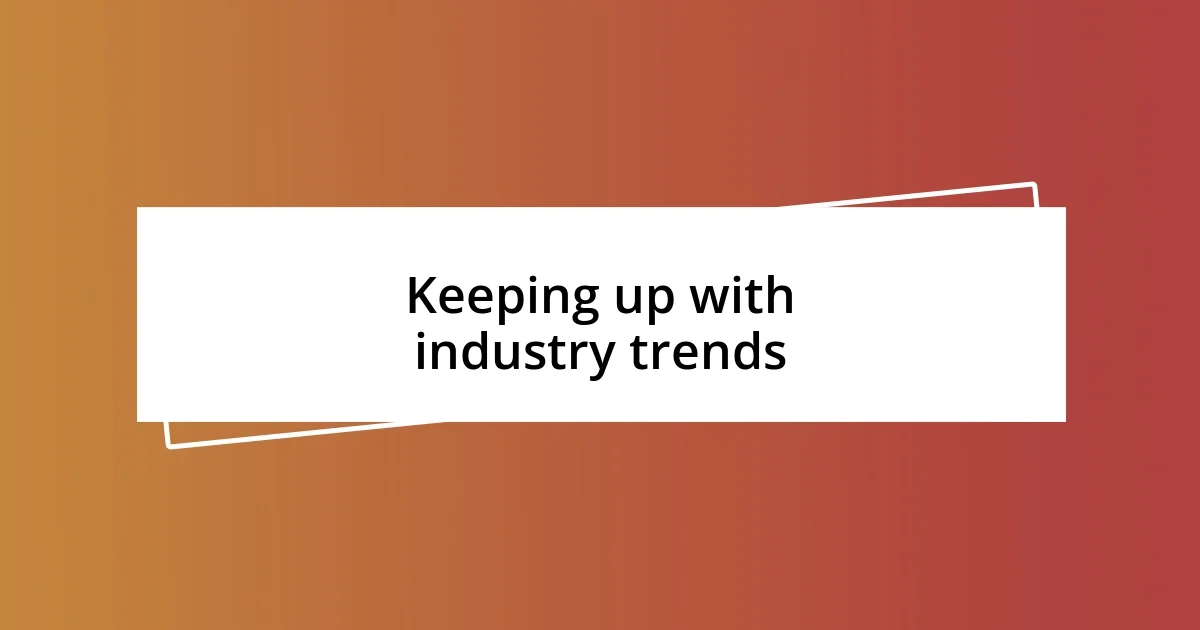Key takeaways:
- Frontend development is focused on creating inviting, visually engaging user experiences, emphasizing the importance of responsive design, clean code, and accessibility.
- Utilizing essential tools such as Visual Studio Code, Figma, Webpack, and Git streamlines the development process and enhances project quality.
- Staying updated with industry trends through community engagement, podcasts, and continuous learning is crucial for innovation and improving user experience.

Understanding frontend development
Frontend development is like the artist’s canvas of the web, where every detail matters. I vividly remember the first time I realized how colors, typography, and layout affect user experience. Have you ever found yourself drawn to a website simply because it felt inviting? That’s the magic of frontend development—it’s about crafting a visual story that engages users and guides them through a seamless journey.
As I delved deeper into this field, I became increasingly aware of the impact that responsive design has on accessibility. I recall working late nights to ensure that a site I built looked just as good on mobile devices as it did on a desktop. It’s fascinating to think about how millions of users access content on their phones. Isn’t it essential to create experiences that resonate with them, no matter the device?
Moreover, mastering frontend development requires a solid understanding of the technologies involved, such as HTML, CSS, and JavaScript. Each language brings its own flavor to the table, allowing for intricate designs and interactive features. I often find myself asking, how can I use these tools to create not just functional, but also delightful experiences? It’s exciting to think that with every line of code, I have the power to shape the way people interact with the web.

Key tools for frontend work
When it comes to frontend development, having the right tools at your disposal can make all the difference. I remember my early days trying to build a simple website without the aid of robust frameworks and tools—it was frustrating, to say the least! Nowadays, I’ve honed in on a set of key tools that not only simplify my workflow but also enhance the overall quality of my projects.
Here’s a list of some essential tools I can’t live without:
- Visual Studio Code: My go-to code editor, offering flexibility with extensions that tailor the experience to my needs.
- Figma: A design tool that has become my secret weapon for creating user interfaces—collaboration feels seamless, which is vital when working with teams.
- Webpack: This module bundler takes care of all the assets and script files, allowing me to focus on building rather than managing.
- Chrome DevTools: The built-in debugging and testing tools really help me analyze performance and fix issues on the fly.
- Git: Version control is non-negotiable for me; it gives me peace of mind knowing I can always revert to a previous state if something goes awry.
Each of these tools holds a special place in my heart because they not only aid in my development process but inspire me to innovate and experiment. I recall a night spent tweaking my Git workflow; the thrill of feeling organized and efficient changed my entire approach to projects. It’s remarkable how the right tools can elevate our work and unleash creativity!

Best practices for coding
When it comes to coding best practices, I often think about the significance of clean code. I’ve found that clarity often makes a world of difference—not just for me, but also for anyone else who might read my code later. I remember a project where I implemented extensive comments and organized my functions meticulously. The relief of coming back to that code weeks later and immediately understanding the logic was incredible! It’s essential to write code that speaks to the reader and flows logically, ensuring that anyone can jump in without deciphering a puzzle.
Another practice I swear by is version control. Early in my career, I learned the hard way about the chaos that ensues without it. Imagine pouring hours into a feature, only to accidentally overwrite it! That’s why I now set up Git branches for every feature or fix. This not only keeps my main branch pristine but also allows me to experiment freely. Maintaining a clear commit history gives me peace of mind, knowing I can always revert to a stable version. Isn’t it nice to have a safety net?
| Best Practice | Description |
|---|---|
| Clean Code | Writing readable and organized code that is easy to understand. |
| Version Control | Using tools like Git to manage code changes and collaboration safely. |
| Modularization | Breaking code into smaller, reusable functions for better maintainability. |

Designing user-friendly interfaces
When I’m designing user-friendly interfaces, I always start with empathy. I ask myself, “What would make this experience smooth and enjoyable for the user?” One time, I was working on a mobile app where feedback was essential. By conducting user testing early on, I discovered that simplifying the navigation significantly enhanced user satisfaction. It’s one of those moments where you realize that prioritizing the user’s perspective can unveil insights that technical specs alone might miss.
In addition to empathy, I embrace consistency in my designs. Users thrive on familiarity, and I’ve learned that maintaining uniformity in elements, colors, and typography helps create an intuitive experience. Just recently, I revamped a web application that had inconsistent button styles, and the difference was night and day. It felt like giving the users a clearer map to navigate through the interface. It’s such a rewarding experience to see how small adjustments can directly enhance usability and overall user engagement.
Lastly, accessibility is something I cannot stress enough. It’s a crucial part of crafting user-friendly interfaces. During a project, I learned the hard way about the importance of color contrast and alternative text for images when a user with visual impairments provided feedback. It opened my eyes to a wider audience that deserves a seamless experience. Are we not obligated to make our work inclusive? By integrating accessibility from the start, we not only broaden our reach but also demonstrate genuine care for all users.

Optimizing performance and load times
Optimizing performance and load times is an essential element of my frontend development approach. I recall a particular project where I was frustrated by sluggish load times. After diving into performance audits, I discovered that unoptimized images were the culprit. By compressing these images without sacrificing quality, I managed to cut the loading time drastically, which not only improved user experience but also boosted my site’s search ranking. Isn’t it amazing how a few tweaks can create such a significant impact?
Another strategy I swear by is minimizing HTTP requests. I remember one project where, despite a beautiful design, the page was taking forever to load due to multiple scripts and stylesheets. By implementing techniques like CSS sprites and combining JavaScript files, I managed to streamline the number of requests significantly. The satisfaction of seeing the page load smoothly in front of my eyes was gratifying—it felt like the design was finally living up to its potential!
I also prioritize asynchronous loading for scripts whenever possible. There was a time when I chose to integrate several plugins that seemed great at a surface level, but they inevitably slowed everything down. By loading scripts asynchronously, I learned to ensure that essential parts of my site could still function while others were still loading. It’s alluring to have all the bells and whistles, but the reality is, no one enjoys waiting. Have you taken the time to analyze how your choices might affect load times? I think it’s crucial to continually reassess and optimize for the benefit of the user experience.

Testing and debugging frontend code
I find that testing and debugging frontend code is akin to being a detective in my own digital world. There was a time when I spent hours trying to figure out a pesky bug on a client’s site. After relentless hunting, I realized I had overlooked the console logs. Once I dived into those logs, the culprit revealed itself—an errant semi-colon that disrupted the entire script! It’s moments like these that remind me how meticulous tolerance can be a game-changer in development.
I also believe in the power of automated testing tools. When I first incorporated a testing framework into my workflow, it completely transformed the way I approached debugging. I vividly recall integrating unit tests for a complex component, and the sense of relief I felt when I ran the tests and caught errors before they went live. It was a real “aha!” moment that made me appreciate the essential role these tools play in catching issues early and ensuring my code remains reliable. Isn’t it comforting to know that we can rely on technology to help us maintain quality?
Another aspect I can’t overlook is user feedback as part of the testing process. I remember launching a new feature only to receive a flood of feedback about a confusing button placement. Instead of feeling discouraged, I saw it as a valuable opportunity for improvement. Implementing user suggestions not only resolved the issues but also deepened my connection with my audience. Have you ever considered how your users can provide invaluable insights for debugging that no code review could ever catch? Embracing user experience in the testing phase has been a game-changer for me.

Keeping up with industry trends
Staying updated with industry trends feels like a continuous learning journey for me. I remember when the concept of CSS Grid first gained traction; I was skeptical at first, thinking my established layout techniques were sufficient. However, after spending a weekend playing around with it, I realized how much more efficient my designs could be. Have you ever felt that spark of realization that pushes you to innovate?
I often find myself diving into online communities and forums to keep my finger on the pulse of frontend development. Just last month, I came across a discussion about the emerging use of JavaScript frameworks like Svelte. Intrigued, I took the time to explore its offerings and even created a small project to test its capabilities. Discovering new tools and techniques not only enhances my skill set but also brings a fresh sense of enthusiasm to my work.
Podcasts and webinars have also become essential in my routine. I vividly recall listening to a podcast episode featuring a seasoned developer discussing the importance of accessibility in web design. It was eye-opening. I realized how easily accessible design positively impacts user experience. Have you had moments like that, where a simple conversation reshapes your perspective? Engaging with these resources fuels my passion and keeps me aligned with evolving best practices in our field.














